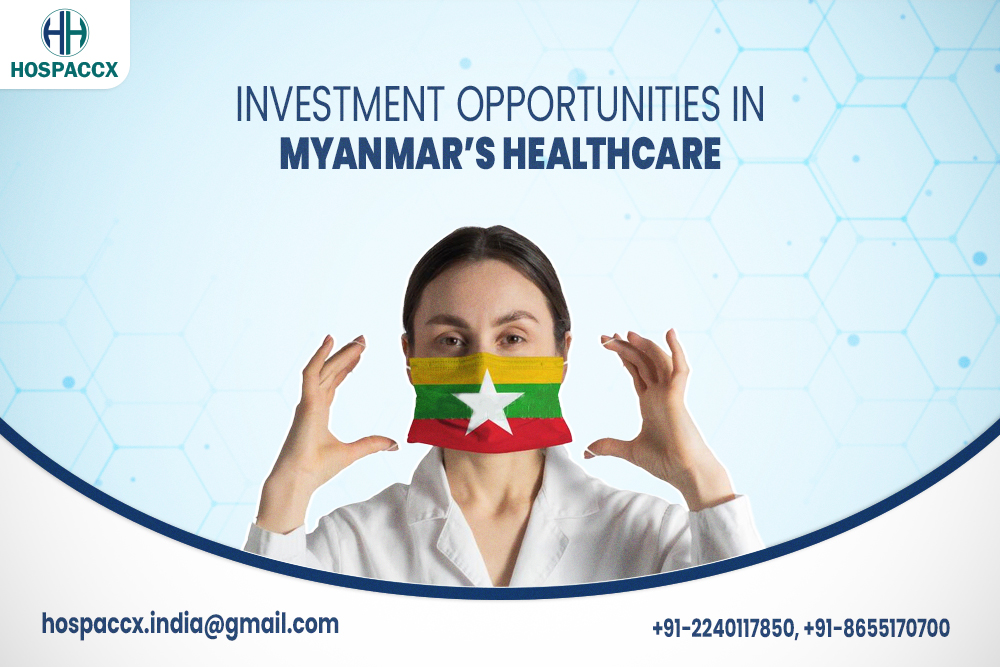Myanmar is one among the developing countries, with various opportunities for a rapid advancement in the quality of healthcare services and delivery systems, through the strong support from the government’s healthcare funding and other investments from Foreign and private investors. If you are interested to venture or make investments into the healthcare, wouldn’t you like to know the actual needs for investments into the healthcare systems of Myanmar? Wouldn’t u ben curious to know about the probable impact of such investments?
Hospacxx Healthcare Consultancy, presents to you bites of information on the investment needs for Myanmar’s healthcare sector, along with the possible influence it would make on its growth and sustainability in the years to come.
MYANMAR’S ECONOMY & IMPACT ON HEALTHCARE
According to a report by the Asian Development bank, the economic growth in Myanmar, which was at a rate of 3.2% % in 2020, was depreciated to a negative value of -18.4% in 2021. Such a depreciation was the main impact of the dreadful COVID situation and the declaration of emergency after the takeover of the military government over the Democratic Political rule. It is predicted that the economy growth would increase to 1% by the end of 2022.
With such a drastic decline in the economy, the healthcare sector has also struggled to sustain the quality of healthcare services, along with its delivery systems, that was still in progress for improvement. Though in comparison to other sectors, a higher percentage of the GDP was allocated as healthcare funding during 2020-2021 by the government in view of the COVID pandemic for resources for testing, treatment and vaccination, it was noted that the opportunities to efficiently utilize those funds were slim. As a result of the sudden political oppression by the Tatmadaw military junta, the infrastructure and operations of healthcare service delivery were adversely affected such that there was non-availability of health centres & its facilities, especially doctors & nurses.
This ultimately led to the deprivation of services which were most wanted by critically ill patients as the number of COVID cases were rapidly increasing. Few hospitals and health centres were damaged and non-functional, especially primary centres and hospitals, as most of the doctors and nurses took part in a rebel movement called the “Civil Disobedience Movement” to retaliate against the unjust rule of the military government. Thus, amongst the chaos of political violence and pandemic attack, the measures taken to improvise the quality of healthcare services were unfortunately found to be ineffective.
With the Healthcare sector, once being one of the least prioritized sectors for the military government, there had been the least healthcare spending by the government till 2011 which was at 1.92 % of the GDP. But after the Democratic Government came into Myanmar’s Political rule in 2012, the emphasis of more focus on the growth of the healthcare sector led to a steady increase in the health care expenditure. In 2019, the healthcare spending is rated at 4.7% of the GDP, thereby observing an increase in the value of healthcare spending. A large portion of these funds has been reserved for training medical professionals, purchasing advanced medical equipment and providing free medical treatment for government employees.
According to a report by Oxford Business School, until 2014, foreigners were barred from investing in Myanmar’s health care sector, but they are now allowed to invest in private hospitals, clinics, diagnostic services and devices, as well as health-related education, provided they do not own more than 80% of the venture. That compares positively with the region, where the investment limits range from 100% in Singapore to 30% in Malaysia. At the same time, Association of South East Asian Nations (ASEAN) has made health care a priority of its economic integration plans, with a focus on trade in pharmaceuticals and medical equipment, as well as the provision of health services and the extension of mutual recognition agreements allowing medical professionals to work throughout the ASEAN region.
As a result, there was more allocation of health professionals to public health centres, especially in rural areas where 70% of the population reside; establishment of a greater number of private hospitals and clinics, pharmaceutical industries and biomedical equipment resourcing companies through increased FDI’s and investments from private companies.
NEEDS FOR HEALTHCARE INVESTMENTS
At present, Myanmar’s investment policies have been revised to a more relaxed manner to allow 70% of asset ownership by foreign investors. Thereby, Myanmar continues to promote more opportunities for healthcare investments by foreigners and private companies as it will facilitate in the advancement of the healthcare sector in the following manner: –
- To facilitate the establishment of a higher number of Rural health centres, Pharmacies and diagnostic centres (Imaging & Laboratories), so as to overcome the gaps in the accessibility, availability and affordability of specialized healthcare services and medications.
- For training & recruitment of higher number of healthcare professionals, through investments into healthcare training institutions, thereby facilitating better allocation of manpower to both private and public health systems in an equitable manner.
- Increase in the number of domestic pharmaceutical factories, that would fulfill the increase in demand & supply of generic & traditional medications, with subsidized costs on imports for the same.
- Increase in the establishments of private insurance companies that would assist the public in availing a more affordable healthcare coverage that would reduce the rate of Out-of-Pocket expenditure.
- To minimize the rate of Outbound Medical Tourism by facilitating more establishment of private hospitals which provide multi-specialty care services of International Health services standards.
- To encourage establishment of private companies for the production and distribution of biomedical equipment, to fulfill the increasing rate demand and supply, thereby subsidizing the expenditure on the imports for basic and advanced equipment.
- To encourage the utilization of digitalized health services through Telemedicine, Diagnostic apps and electronic patient records for a faster and more convenient access of services from healthcare systems.
CONCLUSION
Myanmar is emerging as a country with great number of opportunities for healthcare investors, which would possibly develop the standards of healthcare, with the facilitation of growth with the Healthcare sector and indirectly with the country’s economy.
Hospacxx Healthcare Consultancy, likewise, has worked across Indian and International States on Hospital Projects for Business Process Development, Service Quality Assurance, Financial Management and more. For more information, you can visit the company website on www.hospaccxconsulting.com or contact us directly
Related Team Members










